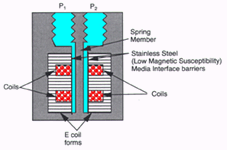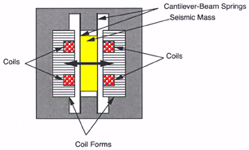THE VARIABLE
RELUCTANCE SENSOR
as a pressure sensor and accelerometer
The variable
reluctance sensor is strain-based, wherein a magnetic circuit
is formed, and the parameter input causes mechanical deflection
of the spring member as a function of pressure, force, or acceleration.
To provide
a static output capability, variable reluctance sensors require
an oscillator and demodulator system internally limiting operational
temperatures from -40 C
to +120 C.
The spring
member is comprised of magnetic, high-permeability material and
is centrally located between two coils as shown.
The Variable
Reluctance Differential Pressure Sensor

The coils are
sealed from the measurand by nonmagnetic welded stainless steel
barriers. In the case of the differential pressure transducer,
the difference in pressure between
the two sides of the spring member will cause distortion of the
spring member towards the magnetic pole piece on the low-pressure
side of the spring member resulting in modulation of the inductance
(L) of the two coils.
The electrical configuration of the variable reluctance sensor
is that of an inductive half-bridge driven by an alternating
voltage source in the range of 1 KHz to 10 KHz. The centrally
disposed spring member results in an inductive push-pull arrangement
where deflection of the spring member reduces the inductance
of one coil and increases the inductance of the other creating
a difference in coil impedance.
The variation
in the magnetic reluctance produces the effective inductance
modulation as a function of the parameter input.
As shown below, the variable reluctance principle may also be
used to fabricate accelerometer structures.
The Variable
Reluctance Accelerometer

This sensing
method is very-well suited to the high accuracy measurement of
static and slowly-varying phenomena a stable null-bias of low
magnitude as well as repeatable thermal errors.

The thermal-sensitivity
shift of the variable reluctance sensor varies with temperature
in much the same way as the LVDT inductance varies with temperature,
in that, the TCR of the coils increases the coil resistance with
increasing temperature, thereby decreasing the current and the
magnetic flux generated.
The use of
a constant-current drive can be used to fix the current at a
constant value irrespective of temperature. A series resistor,
as used in sensitivity compensation of
LVDT sensors, can also be used in series with a voltage source
to simulate a constant-current drive in variable reluctance applications.
The series
resistor is low thermal coefficient of resistance (TCR) and forms
a voltage divider in series with the coils where the voltage
applied to the coils increases with
increasing temperature, thereby resulting in a constant current
and constant-flux condition.
Other active
means may also be employed to maintain a constant coil current
using linearized thermistors and the like.
The mass of the sensor is relatively high and the sensitivity
to thermal transients is correspondingly low. The large diameter
spring element used in low pressure range designs
results in a low spring member resonance and high-acceleration
sensitivity in comparison to the strain-gaged sensor designs.
The pressure
cavities required in differential pressure designs form Helmholtz
cavities, limiting the usefulness of the variable reluctance
design for higher-frequency measurement.
High accuracy
with exceptional stability and 100,000 hours MTBF are key attributes
of this sensor technology.
The diagram
shows the signal-processing block circuit for this sensor type.
The Variable-Reluctance
Circuit Geometry

The variable-reluctance
pressure sensor is available for use at pressures as low as 0.1”
of water to in excess of 10,000 psi.
Some reluctance pressure units are available with replaceable
or interchangeable diaphragms to facilitate the replacement of
an over-ranged diaphragm or to simply install a more flexible
diaphragm for lower-range use. The replaceable diaphragms are
clamped between the two pole pieces. This geometry results in
high stresses concentrated in the clamping zones and lower long-term
stability than in the integrated and welded noninterchangeable
diaphragm variable-reluctance capsules that are also commercially
available.
This extract
is taken from
'The Art of Practical & Precise Strain Based Measurement'
by Jim Pierson.


